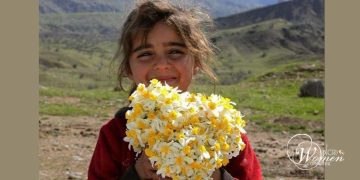Uncovering the Horrific Gas Poisoning of School Girls In Iran
Uncovering the Horrific Gas Poisoning of School Girls In Iran
One of the significant news items in Iran during February and March was the gas poisoning of young women and chemical attacks on girls’ high schools. These cruel acts of biological terror appear to be the Iranian regime’s latest attempt to quash protests and the ongoing six-month revolution led by young women and schoolgirls.
The serial gas poisonings are reminiscent of the atrocities committed by the Nazis against Jews in concentration camps like Auschwitz and serve as a stark reminder of the cruelty of the mullahs’ regime.
This unprecedented crime against humanity underscores the extent to which the clerical regime is willing to go to exact revenge on the brave young women and girls who have defied their authority, torn up pictures of their supreme leader Ali Khamenei, and chanted “death to Khamenei” as they stand up against the oppressive regime in its entirety.
The alarming scope of the disaster: 13,000 students affected
Despite being more than three months into this affair, students continue to be poisoned in cities across Iran. It all began with the first chemical attack on the girls’ Noor Conservatory in Qom on November 30.
Until February 14, the gas poisoning of girl students was mostly limited to schools in Qom. However, on February 14, a girls’ high school in Tehran was targeted, and since then, the chemical attacks have spread across the country.
According to a Health Ministry deputy, Saeed Karimi, 13,000 students had referred to medical centers to receive treatment for gas poisoning. (Mashreq website, March 13, 2023)
To make matters worse, doctors have warned that the symptoms may have long-term consequences for the students’ health, including skin cancer.
The gas poisoning has now spread from high schools to women’s college dormitories in Karaj, Isfahan, Azerbaijan, Boroujerd (Lorestan), and Ardabil, as well as to some elementary schools and a metro station in Tehran.
Tragically, an 11-year-old girl named Fatemeh Rezaii and a first grader named Roham Shahveisi lost their lives after a chemical attack on their school.
There are also unconfirmed reports of the deaths of two elementary school girls in Marand, E. Azerbaijan province (NW Iran), Fatemeh Mehdizadeh, and Shabnam Jamshidi on March 7.

Horrific scenes of the gas poisonings
Hundreds of students have reported feeling nauseous, dizzy, and short of breath after smelling an unpleasant or unknown odor.
One student recounted, “A very bad smell spread in the air, I felt dizzy and fell to the ground.” Another girl described her experience, saying, “When I try to stand up, I feel dizzy, and my body shakes so much that I cannot walk.” Yet another girl reported, “I feel pain in my chest, and my legs shake when I try to walk.”
Eyewitnesses have described heartbreaking scenes of girls crying and falling to the ground. Some were so weak they could not even walk, but they refused to leave their friends alone. One student shared, “They did not let us go home. They made us stay at school. First, there was a foul odor, and then I started feeling ill and wanted to vomit.”
The sciences students of Mohaqqeq Ardabili University in Ardabil also reported their harrowing experience on March 6.
They said, “First, there was a power outage, and the ventilation system turned off. Then, the gas spread. All of us ran out of the building, but unfortunately, some students were poisoned.” The physical and emotional toll on these young students is truly devastating.
The parents of poisoned students took to the streets in Tehran and other cities to express their anger and frustration. They strongly believe that the chemical attacks were targeted and deliberate, and they condemn the officials’ silence and inaction in addressing the issue.

Evidence of government involvement
There is mounting evidence of government involvement in these horrific attacks. Perhaps the most significant indication is the regime’s inaction over the past three months.
As the Donya-e Eghtesad website noted on February 10, “The bitter and suspicious poisonings in schools in Qom Province are reminiscent of the acid attacks in Isfahan. None of these cases have been resolved, and the victims have been left in limbo.”
Moreover, on February 25, the state-run Tabnak website reported the distribution of flyers attributed to the Fedaiyan-e Velayat, a fanatic group affiliated with Supreme Leader Ali Khamenei. The flyers stated that girls’ education is unlawful and threatened to spread the poisonings to girls’ schools across the country if they were not shut down. The fact that a state media outlet published such threats raises serious questions about the regime’s involvement.
Baharnews, another state website, highlighted the regime’s inaction, writing on February 27, “The security services that claim to be able to arrest a dust particle in the air and prevent sabotage activities before they are carried out have not found a single culprit of these terrorist acts so far.” The same source also reported that the Health Ministry’s deputy for research had acknowledged that the gas poisonings were deliberate and aimed at closing girls’ schools.
Despite this evidence, the regime has attempted to shift blame onto foreign intelligence services. The state TV’s anchorman claimed on March 4 that the serial poisonings of students were carried out by espionage services of the West.
However, there are numerous reports of systematic and widespread attacks on schools across the country. For example, the principal and authorities of a boys’ high school in Ilam intimidated and silenced students about a chemical attack. In another boys’ high school in Naghadeh, the principal closed the doors on students and prevented them from leaving or entering the school.
At a girls’ high school in Zanjan (NW Iran), many students were taken to the hospital in the company of plainclothes agents and the State Security Force. Security forces did not allow the medical staff to register the students or take blood tests.
According to Sky News, an eyewitness reported that “security forces arrived at the school and ordered the personnel and the teachers to refrain from talking to anyone about the (chemical) attack. If anyone asked, they should say the smell of gas and the poisoning of students had been caused by broken central heating pipes.”
Massoud Pezeshkian, a member of the parliamentary Health Commission, has also questioned the security services’ handling of the situation, saying, “The security services are able to follow up and make arrests in the shortest possible time when a problem comes up. How can they not see this affair?” (Dideban-e Iran website, March 6, 2023)
Taken together, the mounting evidence suggests that the Iranian regime and the IRGC are involved in these serial gas poisonings.

Conflicting reports and total denial by Iranian officials
The clerical regime is desperately attempting to cover up the truth about its criminal role in the serial gas poisoning of girls. Despite more than three months passing, the regime still propagates lies about this crime and makes conflicting statements.
Initially, regime officials denied the gas poisonings altogether.
On February 6, Siamak Mohebi, the vice president of Qom University of Medical Sciences, stated that the cause of the incidents was the rapid respiration and stress of female students, and that their blood samples were normal. Mohsen Safai Farahani, a member of the regime’s parliament, also said that the incidents had been exaggerated. (Donya-e Eghtesad, February 6, 2023)
On February 15, the Minister of Education, Youssef Nouri, claimed that thegas poisoning was caused by rumors that scared people and students, and that there was no issue. He said those students who had been hospitalized had chronic diseases. (Donya-e Eghtesad, February 15, 2023)
On March 1, Ahmad Vahidi, the Minister of Interior, said, “More than 90% of the poisonings were not due to external factors, but were due to stress and worries caused by the news… there have been no cases where one could decisively say it was due to a specific agent.” (Tasnim.ir, March 1, 2023)
However, after public protests against the regime’s inaction, some officials came out acknowledging that the incidents were a deliberate action.
On February 20, the general public prosecutor, Mohammad Jafar Montazeri, wrote to the Prosecutor of Qom, “There is news of a worrying trend in the type of poisoning in some educational centers in Qom, indicating the possibility of deliberate criminal actions…” (state media, February 20, 2023)
Najafabadi, a member of the parliamentary Health Commission, said, “Both in Qom and in Boroujerd, the cases are deliberate. The Minister of Intelligence has intervened in this case. Unfortunately, however, he has not submitted any report to the parliament.” (Eghtesadonline.ir, February 26, 2023)
Younes Panahi, the deputy Minister of Health, said, “Some people wanted to see all the girls’ schools closed down. What has been clarified so far is that the gas poisonings were due to chemical substances that are available to the public.” (Tabnak.ir, February 27, 2023)
Fatemeh Maghsoudi, a parliamentary deputy from Boroujerd, said, “An examination of the CCTV of schools by security services reveals that the incidents were not natural, and they were deliberate.” (Ham Mihan newspaper, February 27, 2023)
The regime’s president, Ebrahim Raisi, referred to the report of the Minister of Intelligence and stated, “This measure is a link in the chain of conspiracies by the enemy to create tensions in society and disrupt public opinion, creating fear among the country’s children. It must be investigated and dealt with seriously.” (Tasnim.ir, March 6, 2023)
Meanwhile, Ali Khamenei broke his silence after 100 days on March 6 and said, “The authorities, intelligence and security services must seriously follow up this matter… If there are people involved, the operatives and culprits must receive maximum punishments… If some people are identified and convicted as culprits, there should not be any clemency for them.” (Khamenei.ir, March 6, 2023)
However, these statements contradict earlier claims by regime officials denying any deliberate action.

Desperate cover-up attempts
On March 12, 2023, Arman-e Melli newspaper reported the arrest of five individuals involved in the gas poisoning of students in seven schools in Lar, Fars province (S Iran). The report stated that senior military and state officials had previously reported the arrest of individuals involved in the continued and serial poisonings since December in some girls’ schools.
Arman-e Melli added, “The interesting point in the report by the State Television and Radio Network is that the main culprit in this case and his daughter had procured toxic material and used it in seven schools in Lar. They had done so to send the footage to foreign media abroad and destroy people’s trust in the government. They broadcasted the film (of the father and daughter) and talked with a couple of officials, and finally showed the legs of detainees wearing the blue prison pants.”
Despite the arrests, the gas poisonings have not stopped. The Human Rights Staff of the Judiciary says that less than 10% of the students had inhaled a stimulant substance. For the most part, the students were affected by psychological and emotional stress and experienced anxiety.
On March 3, the political and security deputy of the governor of Pardis stated, “The evidence indicates that the parking of a fuel tanker near the school was the reason behind the poisoning of students at Khayyam Pardis School.” (Rokna.ir, March 3, 2023)
However, some regime officials still deny the existence of the poisonings. Mohammad Reza Kalantar Motamedi, secretary of the Medical Sciences’ Cultural Center, said, “There is no cause for worry. There is no disease, at all. This is a mental disease. When someone tells me he feels some way, I feel the same. There is no poisoning. There is no disease. This is hysteria. People think such an incident is happening, not that something physically happened.”
In ridiculous theatrics, the Ministry of Interior also announced the arrest of “more than a hundred people involved in recent school incidents.” According to the Ministry, some of these individuals “acted out of mischief or adventure and used smelly substances to close classrooms.”

Medical staff intimidated into silence
Medical staff and doctors have expressed concern over the gas poisoning incidents, stating that the toxic gases being used are not easily accessible to the public and are being used intelligently in combination. Mohammad Reza Hashemian, a specialist in the special care department of Masih Daneshvari Hospital in Tehran, emphasized the need to identify the source of the poisoning as soon as possible so that doctors can use the appropriate antidote. (Hammihan newspaper, March 3, 2023)
However, doctors and nurses are reportedly afraid to provide information about the injured, as they have been told not to talk or give information on orders from higher authorities and the Ministry of Health itself.
The medical staff and teachers have accused Iranian officials of trying to silence the victims, with officials from the Health Ministry and hospitals preventing doctors from showing the test results to the parents of the affected students.
Hadi Abdollahi, a doctor practicing in the Emergency Ward of Fayazbakhsh Hospital in Tehran, stated that the toxic gases used are not available to the public and could cause genetic mutations or unknown future symptoms.

Targeting families and activists
Instead of arresting the culprits behind the gas poisonings, the regime has taken repressive measures against the families and activists seeking justice for the victims.
On March 6, 2023, the journalist who first reported on the gas poisoning of school girls in Qom was arrested. Additionally, a number of victims and the families of poisoned students have been interrogated by security officials.
Following the gas poisoning of high school students in Tehran on March 1, families and students gathered to hold a protest. However, plainclothes agents brutally attacked the mother of a student outside the 13 Aban High School in Tehran, which was captured on video and went viral on social media.
The families of poisoned students held more protests on March 4, but repressive forces prevented their gathering outside the Ministry of Education. The families continued their protests outside the departments of education in Tehran districts, which were again attacked by the SSF in Tehran, resulting in the beating and arrest of dozens of participants.
On March 5, plainclothes agents and security forces brutally mistreated and arrested some of the parents who held protests outside the Department of Education. In Rasht, they fired tear gas and pepper gas at the protesting parents.
On March 7, the families of poisoned students and teachers held protests in dozens of cities. Students of Allameh University also protested the poisonings, but security forces attacked and arrested a number of them. The next day, 30 students were banned from entering the university.
Security forces also used tear gas and made a number of arrests during protests in Mashhad, Isfahan, Rasht, Shiraz, and Marivan.
Women’s rights activist Sahan Khosravi in Sanandaj was arrested by IRGC intelligence during protests against the poisonings, while retired teacher Bahaeddin Maleki was abducted by security forces in the same city. Amin Mahigir, 34, was arrested and detained after he protested the gas poisoning of students in Sarableh, Ilam.
In a further display of the regime’s intolerance towards dissent, Tehran’s prosecutor announced that they had filed cases against three managing directors of Ham Mihan, Rouydad24, and Sharq dailies for publishing the news of students’ poisoning. Azar Mansouri, Sadeq Zibakalam, and Reza Kianian are accused of publishing false news and unfounded claims that disrupted public opinion instead of publishing accurate and correct information.

Demands for accountability and action
The clerical regime’s attempts to blame foreign powers for the serial poisonings of girls in Iran are an effort to cover up their own role in this heinous crime.
These crimes are being carried out by agencies linked to Khamenei’s headquarters, including the IRGC and others. The continued poisoning of girls throughout the country could not have been done without their intervention.
The world must take action to prevent the Khamenei regime from using human casualties as a means to maintain power, just as they have done during the eight-year war, the 1988 massacre of political prisoners, and the Coronavirus pandemic.
The international community must not remain silent in the face of these atrocities. The WHO should send a delegation to Iran to examine this tragic incident, and the UN and the Human Rights Council must hold the Khamenei regime accountable for this criminal tragedy.
The West must designate the IRGC as a terrorist entity and prosecute the regime’s leaders in international tribunals for their crimes against humanity and violations of human rights.
The Women’s Committee of the National Council of Resistance of Iran condemns these criminal measures by the regime and calls for immediate action to hold those responsible accountable.
We urge the UNSR on violence against women to immediately give a warning to the Iranian regime and undertake this issue. The visit of the UN International delegation to Iran is urgent and imperative. We call on the international community to act now to prevent further harm to the innocent girls of Iran.
























